Text

Why Should Start Using Mechanical Splice Now?
Although the advantages of mechanical splices are well recognized, a major concern has been their high cost for applications where the codes permit the use of lap splices. But is the perception that mechanical splices cost more than lap splices a reality? By using couplers, contractors can be more cost efficient, able to achieve from 20-50% of cost savings compared to lap splicing. Apart from that, there are many other savings which can be anticipated such as;
Reduction no. of joints
6 meters length will be most ideal for joining and this would result in reduction of no. of laps by,
Assuming height of building: 100 metres
Typical floor height: 3.2 metres
No. of laps: 100 / 3.2 = 31 laps
No. of coupler joints: 100 / 6 = 16 joints
Therefore reduction in no. of laps: [(31-16)/31] x 100% = 48%
Minimal wastages of HTDBs
Assuming floor height of 3.2m and lap length of 1.275m
Length of steel bar per floor is : 3.2m + 1.275m = 4.475m
For a 12metres steel bar, two nos of 4.475metres length bar could be prepared.
Balance: 12metres –4.475metres –4.475metres = 3.05metres
By adopting a 6m bar for coupler joint. No wastage is anticipated. Therefore wastage occurred due to lapping is (3.05m/12m)*100% = 25.42%
From above the calculation of mechanical splice, we can see that it is economic to use mechanical splices in the construction, that is reason why we should use rebar splice now.
1 note
·
View note
Text
Why Rebar Coupler to Replace Conventional Lapping
Cost Effectiveness
The conventional method of connecting reinforcement bars with lap joints in reinforced concrete need not be always appropriate. Advantages of simplicity and economy in lap splicing is limited to smaller diameter bars, mechanical couplers offer the solution for splicing when large diameter bars are involved like 20,25,32 and 40mm Diameter where huge cost saving can be done.
Structural Reliability
Coupler spliced perform like continuous reinforcement. That develops full tensile strength mechanically, independent of concrete. Coupler splices are excellent for severe condition like earthquake, typhoon, especially suitable for condition that demands higher ductility of building structure.
Designers Friendly
Rebar-join coupler reduces rebar congestion and improves concrete flow & consolidation. It offers greater flexibility in design options. The simplicity in detailing of reinforcement, particularly in reinforcement congestion zones minimizes the reinforcement fixing errors, detailing and fixing of seismic reinforcement becomes effortless. Workability with higher steel-to-concrete ratio allows optimum sizing of RC structural column.
Contractor’s Choice
Rebar-join coupler offers quality, cost and time saving. Fixing couplers requires no special skills or equipments. Simple mechanical ways in adopting mechanical splicing compared to lapping, accelerates construction schedules for optimum cost and efficiency. It is economical to use couplers for higher diameter rebar as it saves on considerable weight and rebar wastage.
1 note
·
View note
Text

Different Diameters Rebar Sleeve
Rebar reducing sleeve are used to connect steel bars of different diameters. The rebar reducing sleeve models are 18 to 16, 20 to 18, 22 to 20, 22 to 18, 25 to 22, 25 to 20, 25 to 18, 28 to 25, 28 to 22, 32 to 28, 32 to 25 , 36 to 32, 36 to 28, 40 to 36mm, etc.
Rebar reducing sleeve can be widely used in reinforced concrete structure engineering in steel bars in various industrial and civil buildings. It is especially suitable for high-rise buildings, roads, bridges, subways, tunnels, power stations, dams and other buildings and structures with high explosion-proof and earthquake-proof requirements.
Changsha DLADTO Rebar Splice Co., Ltd as a division of ADTO Group. We are a professional rebar coupler producer, we have been in this field for a long time with customers for all over the world. Welcome to contact us for any inquiry.
1 note
·
View note
Text

What is the Difference between the Grade I, II, III of Rebar Coupler
In the building construction, steel bar is an indispensable material, and steel bar joints are an important part to connect steel bars in construction. According to different connection strength requirements and connection methods, couplers can be divided into first-level joints, second-level joints, and third-level joints. What is the difference between them?
1. Different mechanical properties
Grade I joint: the tensile strength of the joint is greater than or equal to the actual tensile strength of the steel bar to be connected or 1.10 times the standard value of the tensile strength of the steel bar, and it has high ductility and repeated tension and compression properties;
Class II joint: the tensile strength of the joint is not less than the standard value of the tensile strength of the connected steel bar, and has high ductility and repeated tension and compression properties;
Grade III joint: The tensile strength of the joint is not less than 1.25 times the standard value of the yield strength of the steel bar to be connected, and has certain ductility and repeated tension and compression properties.
2. Different joint percentages
There is no limit range for the joint percentage of Class I joints unless there are special requirements;
The percentage of joints of grade II joints shall not be greater than 50%;
The joint percentage of Class III joints shall not exceed 25% in the same joint section.
1 note
·
View note
Text

Extend Rebar Coupler Advantages
Extend rebar coupler is designed for long, large, and dense bars being installed on site, and it is not convenient to rotate the re-bars. The extended rebar coupler is longer than the normal steel couplings.
Product advantages:
1. Raw material-saving, high energy saving, high work efficiency.
2. Construction environmental protection. No flame, no noise pollution.
3. It is not be affected by the chemical compositions and types of reinforced bars and won't be influenced by weather and work-site.
4. Low cost, simple operation.
5. Can be prefabricated and the construction period can be shortened.
6. High dimension precision, reliable quality and stable performance.
7. High strength. The tensile strength usually more than 600 Mpa, it can reach 110% of yield strength of parent rebar.
8. After 2 million times of fatigue strength test, the connection is in good condition.
9. According to the inspection of national construction quality supervision and testing center, the rebar coupler joint performance has reach the grade I splicing rebar joint of JGJ107-2016 Industry Standard.
1 note
·
View note
Text
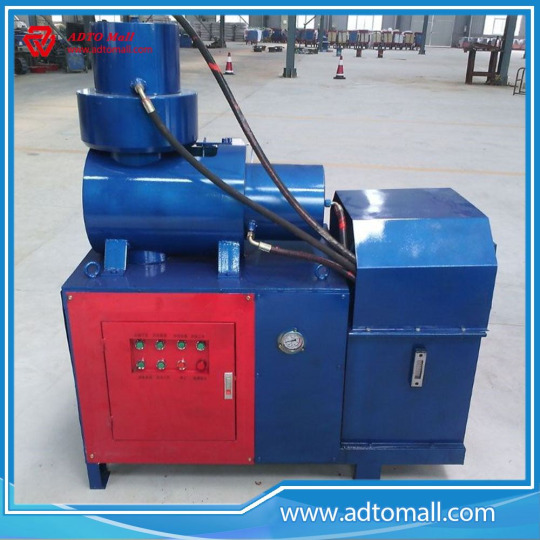
Advantages of Rebar Upsetting Machine
Advantages of rebar upsetting machine:
1. Simple operation, hydraulic and electrical control, no need for professional skills, and it can be turned on and operated after short-term training.
2. Expand the cross-sectional area of the end of the steel bar by 15-20%, so that the bottom diameter of the processed thread is not less than the diameter of the base material of the steel bar.
3. The steel bar upsetting machine has high production efficiency, upsetting 1 end in 10-15 seconds.
4. The processing range of steel bars is wide, and the steel bars with diameters of 16-40 can be processed.
5. It has the advantages of light weight, generous appearance, fast speed and flexible use. 6. The steel upsetting machine is environmentally friendly, safe and not affected by the environment and climate
1 note
·
View note
Text
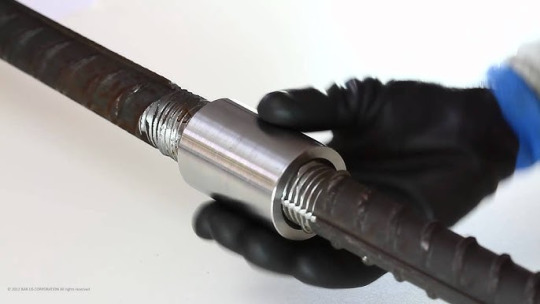
Four Types of Mechanical Connection
Mechanical connections has four types:
Rebar sleeve extrusion connection
It is used for on-site connection construction of grade Ⅱ and Ⅲ hot-rolled ribbed steel bars with a diameter of Ф20-32mm in reinforced concrete structures according to the requirements of first and second-level seismic fortification.
Rebar taper thread sleeve connection
It is used for the connection between steel bars with the same diameter or different diameters of Ф18-50mm grade II, III, and IV ribbed steel bars (including poorly weldable steel bars).
Reinforcement upset straight thread sleeve connection
It is used for the on-site connection construction of II, III grade vertical, oblique or horizontal steel bars with a steel bar diameter of Ф16-40mm in the concrete structure of industrial and civil buildings.
Steel bar rolling straight thread sleeve connection
Steel bar rolling straight thread sleeve connection is utilizes the characteristics of plastic deformation of metal materials and cold hardening to enhance the strength of metal materials, so that the joint and the base metal are equally strong. According to the rolling straight thread forming method, it can be divided into three types: direct rolling thread, extruded rib rolling thread, and stripped rib rolling thread.
1 note
·
View note
Text

Characteristic of Threaded Joint
Threaded joints is coupler with threads. It is a relatively common in industry and daily life. The threaded joint makes the rebar connection easier to disassemble and replace, and it is cost-effectively.
The characteristics of threaded joints are as follows:
1. It has high strength and good ductility, which can give full play to the strength and ductility of the steel base material.
2. Easy to operate, fast and easy to connect.
3. The detection is convenient and intuitive.
4. The straight thread processing for steel bar can be prefabricated, and the coupler can be manufactured in a factory, which doesn't occupy the construction period and has high processing efficiency.
5. Itis environmental protection during construction and connection, and can be constructed around the clock.
6. It has strong applicability that can be flexibly used in narrow place.
7. It can connect horizontal, vertical and inclined HRB335 and HRB400 steel bars of the same or different diameters.
1 note
·
View note
Text

How To Adjust Positive And Negative Thread On Thread Cutting Machine ?
1 Remove the eccentric bushing and eccentric shaft from the thread holder, loosen the screws first, and then use a special wrench for the eccentric bushing to rotate the eccentric bushing 180 degrees . Then, place the loosened screws into the screw hole after the rotation of 180 degrees and tighten them (the rolling head and rib stripping head are equipped with 3 eccentric bushing, each with a 180 degree rotation, and tighten them by changing the screw hole).
2 Install the threading roller and place it counterclockwise in 1-2-3 (POSITIVE THREAD)
Install the threading roller and place it anticlockwise in 3-2-1 (NEGATIVE THREAD)
3 Upper the rib stripping machine head, tighten the screws, adjust the test bar, and start working
1 note
·
View note
Text

Remedial Measure for Incorrect Position of Rebar Connector
The issues should be considered comprehensively during the construction of steel bar connectors: the position of the joint should be arranged at a position with less stress, and the ground joints of adjacent steel bars should be properly staggered to facilitate operation. Choosing the right type coupler and thread directing according to the actual situation of the floor and reinforcement to adjust it in time.
Remedial measures for incorrect position of rebar connectors
If the position of the joint is not correct, the first thing to do is contact the designer, and the following measures usually be taken to remedy it.
1. The position deviation of the joint is small, which can be solved by adjusting the bending angle of the connecting steel bar, but it must meet the requirements of 1/6 of the specification and get the designer approval in advance.
2. The joint position deviation of the steel bar connector is large. Edge beams can be constructed first at the connector locations, converting the bottom reinforcement and diaphragm walls to connections between the bottom and edge beams. This method must be approved by the designer in advance.
1 note
·
View note
Text

Methods of Mechanical Connection
The mechanical connection methods of steel bars include: ribbed steel sleeve extrusion connection, steel bar taper thread connection and steel bar equal-strength thread sleeve connection.
1. Sleeve extrusion connection joint: the joint formed by the plastic deformation of the steel sleeve of the connecting piece and the tight bite of the ribbed steel bar through extrusion force.
2. Tapered thread connection joint: a joint formed by the special tapered thread at the end of the steel bar and the tapered thread of the connecting piece.
3. Equal-strength straight thread connection joints: The quality of the joints is stable and reliable, and the connection strength is high, which can be compared with the sleeve extrusion connection joints, and it also has the characteristics of convenient and fast construction of the tapered thread joints.
Changsha DLADTO Rebar Splice Co., Ltd as a division of ADTO Group. We are a professional rebar coupler producer, we have been in this field for a long time with customers for all over the world. Welcome to contact us for any inquiry.
1 note
·
View note
Text

Reinforcement Joint Stagger Distance Specification
1. The joint should be set at less stress place of steel bar. Two joints should not be set in a steel bar. The joints of longitudinally stressed steel bars in the same reinforcement members should be staggered from each other.
2. It is strictly forbidden to use overlapping joints diameter over 16mm steel bars, which should take welded connection or mechanical connection.
Illustrate:
1. Lap joint connection: The lap joint length should meet the design and specification requirements, and the adjacent steel bar joints should be staggered by 50%; the joint stagger height should be 1.3 times over the lap joint length.
2. Mechanical connection: the finished concrete surface of the joint should over 50cm, and the joints of adjacent steel bars should be staggered by 50%; the height of joint stagger should not be less than 35d.
3. Welding connection: the finished concrete surface of the joint should not be less than 50cm, and the adjacent steel bar joints should be staggered by 50%; the height of the joint stagger should be over35d and not less than 50cm.
1 note
·
View note
Text

How Many Steel Wire Heads can a Straight Thread Rolling Machine Make in One Hour
Many customers may want to know how many steel wire heads can your straight thread rolling machine make in one hour before purchase threaded rolling machine.
Straight threaded rolling machine manufacturers DLADTO are here to explain this issue to you. First, how many thread heads a thread rolling machine can rolls in an hour is determined by the motor and reducer of the machine. Also, it is determined by the type of steel bar too. Sure. Now that, we will introduce you the types of threaded rolling machines that used in the market.
HGS-40 Ordinary Straight Thread Rolling Machine--Adopts 4.5kw motor and reducer at a rate of 1:19, suitable for processing 16, 18, 20, 22, 25 HRB400 steel bars. The number of processing per hour is about 400-800 pcs.
HGS-40 Reinforced Rebar Threading Machine--It adopts 5.5kw motor and reducer with a speed of 1:17, which is able to processing all specifications of HRB400 steel bars. The number of processing per hour is about 300-1000 pcs.
If the processing steel bars are 36, 40, it is recommended to modify the motor to 75 million and the speed reducer to 1:15, so that it can be processed faster and efficiently.
1 note
·
View note
Text
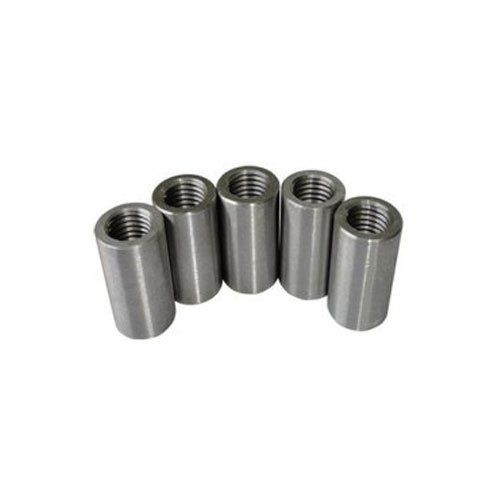
Rolled Straight Threaded Rebar Splice
Rolled straight threaded rebar splice is the joint formed by rolling the end of the steel bar or the extrusion (rolling) of the rib rolling or the stripping of the rib and the rolling of the straight thread and the thread of the connecting piece.
The basic principle is to use the characteristics of metal materials that are plastically deformed and then cold hardened to enhance the strength of metal materials, and the plastic deformation and cold hardening occur on the surface of the metal, while the performance of the original metal is still maintained inside the metal, so that the steel bar joint and the base metal reach equal strength.
There are three types of rolled straight threaded rebar splice: direct rolled threaded, extruded (rolled) rib rolled threaded, and stripped rib rolled threaded. The threaded accuracy and size obtained by these three types of connection joints are different, and the quality of the joints also different.
1 note
·
View note
Text
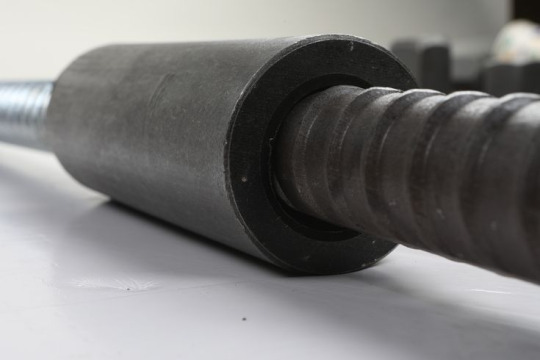
Workers may encounter the problem that the rebar sleeve cannot be screwed on the wire head during the construction. Why the threaded steel sleeve cannot be tightened? Here let's talk about the reason:
1. The threaded pitch of rebar sleeve is different from that of the wire head.
The pitch of Φ16, Φ18, Φ20, Φ22 rebar sleeve is 2.5mm, and Φ25, Φ28, Φ32, Φ36 rebar sleeve is 3.0mm.
The pitches of Φ40 steel sleeves are 3.0mm and 3.5mm.
2. The tooth angle of the rebar sleeve of the steel bar is different from the tooth angle of the steel wire head. There are two types of rebar sleeve with tooth angles of 75° and 60°.
3. The wire hood is too big. Due to the insufficient adjustment accuracy of the rolling mill during the threading process, there will be deviations. The wire head cover is too large, or the gear plate of the steel bar rolling machine is not compressed, and the eccentric shaft of the rolling machine has moved.
Above are reasons may cause the threaded rebar sleeve fail to be tightened, so the on-site construction have to analysis the reason to find solution.
1 note
·
View note
Text
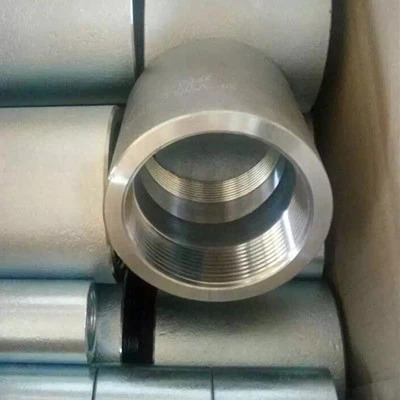
Distinguishing method of positive and negative thread couplers of straight thread couplers
How to distinguish the positive and negative wire coupler s of straight threaded couplers, how to distinguish the positive and negative wire couplers of straight threaded couplers?
There are two ways to distinguish the positive wire and the reverse wire in the conventional straight thread connection coupler , as follows.
You can hold the threaded connection coupler with your right hand. If the helix angle of the thread is in the direction of the thumb, it is a positive thread; if it is the opposite, it is a reverse thread.
If you hold it in your hand and rotate clockwise, it can be screwed in, and if it is rotated counterclockwise, it is a positive wire;
It can also be seen with the naked eye that each coupler of the coupler has a corresponding steel stamp.
1 note
·
View note
Text
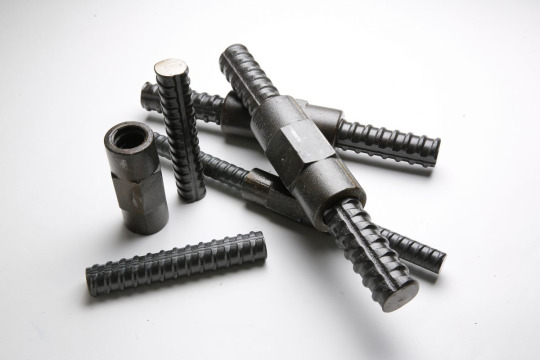
What is Primary Rebar Sleeve
Rebar sleeve connection is mechanical connection, which is divided into grades I, II , III. The grade I is that the tensile strength of the joint is not less than the actual tensile strength of the connected steel bar or 1.10 times the standard value of the tensile strength of the steel bar, and has high ductility and repeated tension and compression.
The grade II is that the tensile strength of the street is not less than the standard value of the tensile strength of the connected steel bar, and has high ductility and repeated tension and compression properties. The grade III is that the tensile strength of the street is not less than 1.35 times the standard value of the yield strength of the connected steel bars, and has certain ductility and repeated tension and compression properties.
The primary rebar sleeve is tensile strength of the first-level sleeve reaches or exceeds 596Mpa. In another word, the primary sleeve is a steel bar connection sleeve that reaches or exceeds 1.1 times the tensile strength of the steel bar base material.
Changsha DLADTO Rebar Splice Co., Ltd as a division of ADTO Group. We are a professional rebar coupler producer, we have been in this field for a long time with customers for all over the world. Welcome to contact us for any inquiry.
1 note
·
View note